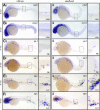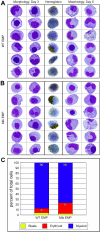Notch signaling distinguishes 2 waves of definitive hematopoiesis in the zebrafish embryo
- PMID: 20107232
- PMCID: PMC2854425
- DOI: 10.1182/blood-2009-09-244590
Notch signaling distinguishes 2 waves of definitive hematopoiesis in the zebrafish embryo
Abstract
Recent studies have revealed that definitive hematopoiesis in vertebrates initiates through the formation of a non-self-renewing progenitor with limited multilineage differentiation potential termed the erythromyeloid progenitor (EMP). EMPs are specified before hematopoietic stem cells (HSCs), which self-renew and are capable of forming all mature adult blood lineages including lymphoid cells. Despite their differences, EMPs and HSCs share many phenotypic traits, making precise study of their respective functions difficult. Here, we examine whether embryonic specification of EMPs requires Notch signaling as has been shown for HSCs. In mindbomb mutants, which lack functional Notch ligands, we show that EMPs are specified normally: we detect no significant differences in cell number, gene expression, or differentiation capacity between EMPs purified from wild-type (WT) or mindbomb mutant embryos. Similarly N-[N-(3,5-difluorophenacetyl)-l-alanyl]-S-phenylglycine t-butyl ester (DAPT), a chemical inhibitor of Notch receptor activation, has no effect on EMP specification. These studies establish that HSCs are the only hematopoietic precursor that requires Notch signaling and help to clarify the signaling events underlying the specification of the 2 distinct waves of definitive hematopoiesis.
Figures




Similar articles
-
Definitive hematopoiesis initiates through a committed erythromyeloid progenitor in the zebrafish embryo.Development. 2007 Dec;134(23):4147-56. doi: 10.1242/dev.012385. Epub 2007 Oct 24. Development. 2007. PMID: 17959717 Free PMC article.
-
CD41+ cmyb+ precursors colonize the zebrafish pronephros by a novel migration route to initiate adult hematopoiesis.Development. 2008 May;135(10):1853-62. doi: 10.1242/dev.015297. Epub 2008 Apr 16. Development. 2008. PMID: 18417622 Free PMC article.
-
Primary cilia regulate hematopoietic stem and progenitor cell specification through Notch signaling in zebrafish.Nat Commun. 2019 Apr 23;10(1):1839. doi: 10.1038/s41467-019-09403-7. Nat Commun. 2019. PMID: 31015398 Free PMC article.
-
Notch signaling and the emergence of hematopoietic stem cells.Dev Dyn. 2020 Nov;249(11):1302-1317. doi: 10.1002/dvdy.230. Epub 2020 Aug 28. Dev Dyn. 2020. PMID: 32996661 Review.
-
The Notch pathway in the developing hematopoietic system.Int J Dev Biol. 2010;54(6-7):1175-88. doi: 10.1387/ijdb.093049ab. Int J Dev Biol. 2010. PMID: 20711994 Review.
Cited by
-
Essential role for Gata2 in modulating lineage output from hematopoietic stem cells in zebrafish.Blood Adv. 2021 Jul 13;5(13):2687-2700. doi: 10.1182/bloodadvances.2020002993. Blood Adv. 2021. PMID: 34170285 Free PMC article.
-
The Notch signaling pathway in hematopoiesis and hematologic malignancies.Haematologica. 2011 Dec;96(12):1735-7. doi: 10.3324/haematol.2011.055954. Haematologica. 2011. PMID: 22147769 Free PMC article. No abstract available.
-
Modeling hematopoietic disorders in zebrafish.Dis Model Mech. 2019 Sep 6;12(9):dmm040360. doi: 10.1242/dmm.040360. Dis Model Mech. 2019. PMID: 31519693 Free PMC article. Review.
-
Discrete Notch signaling requirements in the specification of hematopoietic stem cells.EMBO J. 2014 Oct 16;33(20):2363-73. doi: 10.15252/embj.201488784. Epub 2014 Sep 17. EMBO J. 2014. PMID: 25230933 Free PMC article.
-
Human definitive haemogenic endothelium and arterial vascular endothelium represent distinct lineages.Nat Cell Biol. 2015 May;17(5):580-91. doi: 10.1038/ncb3161. Epub 2015 Apr 27. Nat Cell Biol. 2015. PMID: 25915127 Free PMC article.
References
-
- Weissman I, Papaioannou V, Gardner R. Fetal hematopoietic origins of the adult hemato-lymphoid system. In: Clarkson B, Mark P, Till J, editors. Differentiation of Normal and Neoplastic Hematopoietic Cells. Vol 5. New York, NY: Cold Spring Harbor Laboratory Press; 1978. pp. 33–47.
-
- Yoder MC, Hiatt K, Dutt P, Mukherjee P, Bodine DM, Orlic D. Characterization of definitive lymphohematopoietic stem cells in the day 9 murine yolk sac. Immunity. 1997;7(3):335–344. - PubMed
-
- Cumano A, Ferraz JC, Klaine M, Di Santo JP, Godin I. Intraembryonic, but not yolk sac hematopoietic precursors, isolated before circulation, provide long-term multilineage reconstitution. Immunity. 2001;15(3):477–485. - PubMed
-
- Dzierzak E. The emergence of definitive hematopoietic stem cells in the mammal. Curr Opin Hematol. 2005;12(3):197–202. - PubMed
Publication types
MeSH terms
Substances
Grants and funding
LinkOut - more resources
Full Text Sources
Molecular Biology Databases

